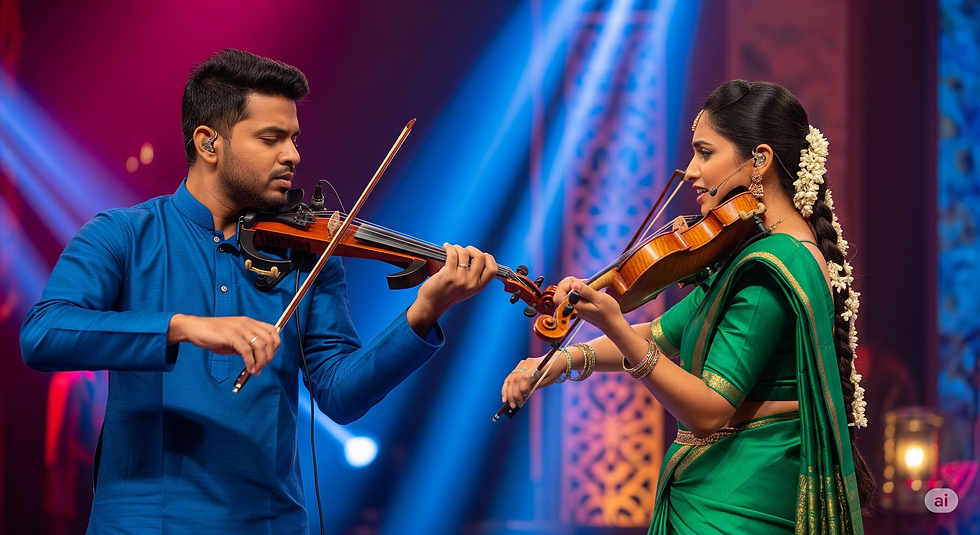"The Global Voyage of the Carnatic Violin: Bridging Cultures, Shaping Sounds"
- Sharanya naidu
- Sep 3, 2024
- 3 min read
Updated: Oct 16, 2024
The violin, an instrument with deep roots in Western classical music, has found a unique and cherished place in Carnatic music, one of India's oldest and most revered classical music traditions. Its journey from European concert halls to the global stage of Carnatic performances is a fascinating story of adaptation, innovation, and cultural exchange. For music learners, understanding how the violin has been embraced and transformed in Carnatic music offers valuable insights into the dynamics of musical traditions and the ways in which they evolve.
The Violin's Entry into Carnatic Music
The violin was introduced to Carnatic music in the early 19th century by Baluswami Dikshitar, the brother of the famous composer Muthuswami Dikshitar. Fascinated by the instrument's versatility and ability to mimic the nuances of the human voice, Baluswami Dikshitar adapted the violin to suit the specific needs of Carnatic music. He modified the tuning, adjusted the playing posture, and developed new techniques that allowed the violin to express the microtonal inflections (gamakas) and intricate rhythmic patterns that are central to Carnatic music.
Since then, the violin has become an integral part of Carnatic music, often used as both an accompanying instrument in vocal performances and as a solo instrument. Its ability to sustain notes, produce a wide range of dynamics, and execute rapid passages has made it a favorite among Carnatic musicians and audiences alike.
Global Expansion and Cultural Adaptations

As Carnatic music gained global recognition, the violin's role within the tradition began to expand and evolve. Indian musicians who traveled abroad brought the violin with them, introducing it to new audiences and collaborating with artists from diverse musical backgrounds. These global encounters led to exciting adaptations and reinterpretations of the Carnatic violin tradition.
In the United States, for example, Carnatic violinists have collaborated with jazz musicians, creating a fusion of styles that blends the improvisational nature of both genres. Artists like L. Shankar and L. Subramaniam have been pioneers in this area, experimenting with electric violins and incorporating elements of Western harmony and orchestration into their performances.
In Europe, Carnatic violinists have collaborated with Western classical musicians, exploring the intersections between these two rich traditions. The violin's ability to traverse different musical worlds has enabled such collaborations to flourish, resulting in performances that highlight both the distinctiveness and the commonalities of these traditions.
Interpretations Across Cultures
The cultural adaptations of the Carnatic violin have also led to new interpretations of ragas (melodic frameworks) and talas (rhythmic cycles). In global contexts, Carnatic musicians often present familiar ragas in innovative ways, sometimes incorporating non-traditional scales or rhythms to appeal to diverse audiences. These reinterpretations not only showcase the versatility of the Carnatic violin but also underscore the dynamic nature of Carnatic music itself, which continues to evolve in response to new influences.
Moreover, the exchange of musical ideas across cultures has enriched the Carnatic violin tradition. For instance, the influence of Western classical techniques has led to a greater emphasis on bowing techniques and tone production in Carnatic violin playing. Similarly, the exposure to jazz and other improvisational genres has inspired Carnatic musicians to experiment with new forms of expression within the framework of traditional ragas and talas.
Learning from the Global Carnatic Violin Tradition
For music learners, the global journey of the Carnatic violin offers several important lessons. First, it highlights the importance of adaptability in musical traditions. The violin's successful integration into Carnatic music demonstrates how instruments and styles can be reimagined and recontextualized to fit new cultural settings.
Second, the global expansion of the Carnatic violin tradition underscores the value of cross-cultural collaboration and exchange. By engaging with musicians from different traditions, Carnatic violinists have not only broadened their own musical horizons but also contributed to the global appreciation of Indian classical music.
Finally, the story of the Carnatic violin serves as a reminder that music is a living art form, constantly evolving and responding to new influences. As learners, embracing this spirit of exploration and innovation can lead to exciting new possibilities in your own musical journey.
Conclusion
The violin's journey in global Carnatic performances is a testament to the power of music to transcend cultural boundaries and adapt to new contexts. Through its adaptations and interpretations across cultures, the Carnatic violin has become a symbol of the dynamic and evolving nature of Carnatic music. For music learners, exploring this tradition offers not only a deeper understanding of the violin's role in Carnatic music but also a broader appreciation of the ways in which music can connect and inspire people across the world.
For personalized 1:1 violin lessons with top instructors, message us on WhatsApp.



Comments